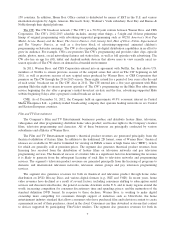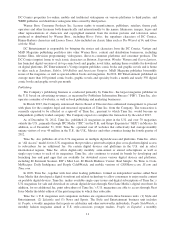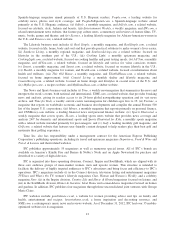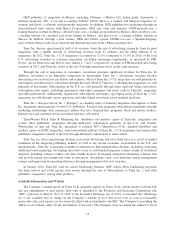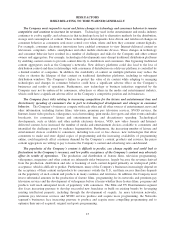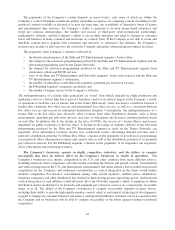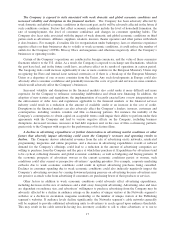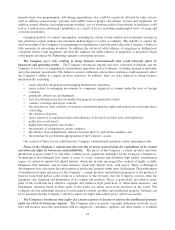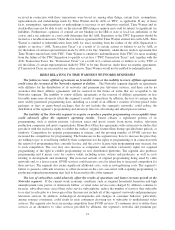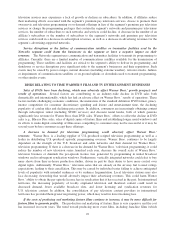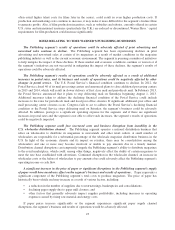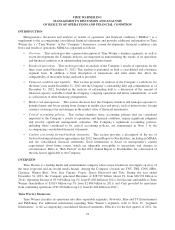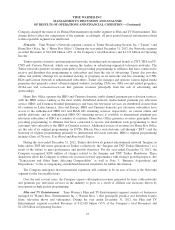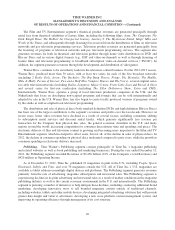Time Magazine 2012 Annual Report Download - page 32
Download and view the complete annual report
Please find page 32 of the 2012 Time Magazine annual report below. You can navigate through the pages in the report by either clicking on the pages listed below, or by using the keyword search tool below to find specific information within the annual report.The popularity of the Company’s content depends on many factors, only some of which are within the
Company’s control. Examples include the quality and public acceptance of competing content (including locally
produced content) available or released at or near the same time, the availability of alternative forms of leisure
and entertainment time activities, the Company’s ability to maintain or develop strong brand awareness and
target key audience demographics, the number and success of third-party retail promotional partnerships,
marketing by affiliates, and the Company’s ability to successfully anticipate and adapt to changes in consumer
tastes and behavior in many countries and territories on a timely basis. If the Company is not able to create and
distribute content that is popular with consumers and attractive to advertisers and affiliates, the Company’s
revenues may decline or fail to grow to the extent the Company anticipates when making investment decisions.
The popularity of the Company’s content is reflected in:
• the theatrical performance of the Film and TV Entertainment segment’s feature films,
• the ratings for the television programming produced by the Film and TV Entertainment segment and the
television programming aired by the Turner Networks,
• the demand for television programming produced by the Film and TV Entertainment segment from
syndication outlets and SVOD services,
• sales of the Film and TV Entertainment and Networks segments’ home video releases and the Film and
TV Entertainment segment’s videogames,
• the number of subscribers to the Networks segment’s premium pay television services,
• the Publishing segment’s magazine circulation, and
• the number of unique visitors to the Company’s websites.
The underperformance of a feature film, particularly an “event” film (which typically has high production and
marketing costs) or a feature film that is part of a franchise, can have an adverse impact on the Company’s results
of operations in both the year of release and in the future. Historically, there has been a correlation between a
feature film’s domestic box office success and international box office success, as well as a correlation between
box office success and success in subsequent distribution channels. Consequently, the underperformance of a
feature film at the box office may adversely affect revenues from other distribution channels, such as home
entertainment, premium pay television services, and sales of videogames and licensed consumer products based
on such film. In addition, due to the decline in the sales of DVDs, the success of a feature film is much more
dependent on public acceptance at the box office. A decline in the ratings or audience delivery of the television
programming produced by the Film and TV Entertainment segment or aired on the Turner Networks can
negatively affect subscription revenues, license fees, syndication results, advertising demand and rates and a
network’s distribution potential. For Home Box Office, a decline in the popularity of its television programming
can negatively affect subscription revenues and content sales as well as the distribution potential of its premium
pay television services. For the Publishing segment, a decline in the popularity of its magazines can negatively
affect subscription and advertising revenues.
The Company’s businesses operate in highly competitive industries, and the failure to compete
successfully may have an adverse effect on the Company’s businesses or results of operations. The
Company’s businesses face intense competition in the U.S. and other countries from many different sources,
including numerous direct competitors and other media, including the Internet and pirated content. Consolidation
and vertical integration in the U.S. and international entertainment and media industry have resulted in increased
competition for the Company, and additional consolidation or vertical integration in the future would further
intensify competition. For instance, consolidation among cable system operators, satellite service distributors,
telephone companies and other distributors has resulted in them having greater negotiating power, and increased
vertical integration of such affiliates could adversely affect the Networks segment’s ability to maintain or obtain
distribution and/or marketing for its networks and premium pay television services on commercially reasonable
terms, or at all. The ability of the Company’s businesses to compete successfully depends on many factors,
including their ability to provide high-quality popular content, adapt to and exploit technological developments,
respond to changes in consumer behavior and achieve widespread distribution, and there can be no assurance that
the Company and its businesses will be able to compete successfully in the future against existing or potential
competitors.
16



